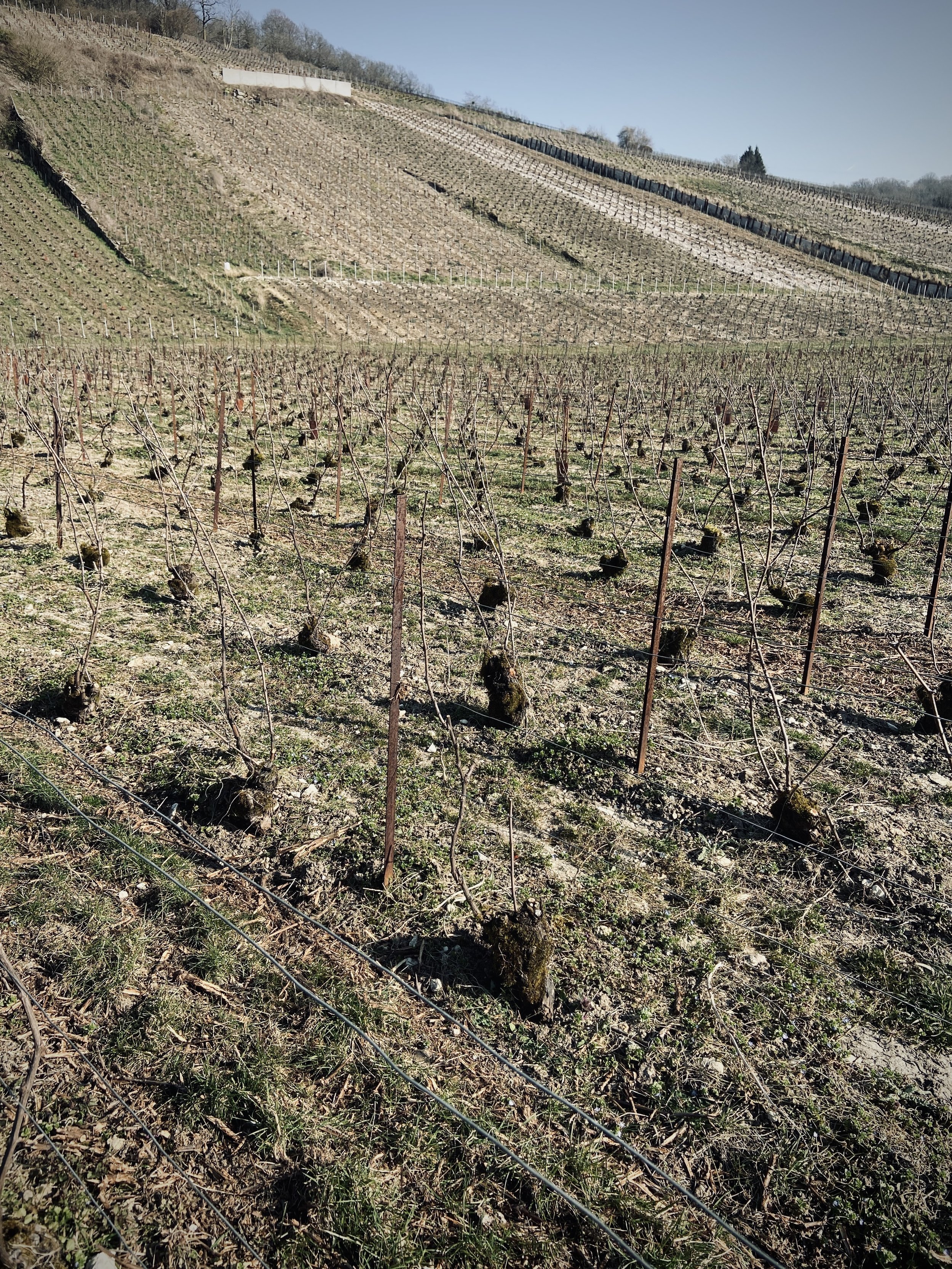CHRISTOPHE MIGNON
-
We drove southwest from Epernay for a little less than an hour to reach Christophe Mignon's winery in Le Mesnil-Le-Huttier. Located in Champagne's coolest subregion, the Vallée de la Marne, his vineyards span two villages: Festigny and Le Breuil. Situated along the Flagot tributary, their primarily south-facing sites are on limestone and the region's famed and unique green clay.
Christophe is a fifth-generation farmer. His great-grandparents planted several of the thirty plots he now works, including his fifty-year-old Pinot Meunier. Before he took over the estate, his parents avoided heavy-handed chemical treatments, which could explain why his vines are so well adapted. He made his first wine at eighteen in 1983 from 19 ares, but his holdings have grown to 6.3ha.
-
His love for Pinot Meunier is no secret. It accounts for nearly 90% of his plantings. Unlike many who see it as a necessary evil, providing yields in cold vintages and making wines for early consumption, he noticed its true potential. When cropped appropriately, farmed with the utmost attention to detail, and not masked with sugar or extended lees aging, it could be a complex conduit for terroir. His old plots are an excellent source of vine material for selection massale.
-
At a young age, Aikido made Christophe aware of the connection between our bodies and nature. He likens it to Feng Shui, trying to work in synergy with your surroundings. For the last twenty years he has conducted his farming and winemaking in concordance with the lunar calendar. He'll often refer to it as a metronome, keeping him in time with nature. What started as an experiment behind his father's back has resulted in a longer growing season, even in warm vintages. He is anything but dogmatic, borrowing techniques from various sources, including biodynamics (trained by Pierre Masson).
He uses a modified version of plant homeopathy, making his own extracts in a rotating heptagonal Vitalsel. This decreases his use of copper drastically, improving soil health. He'll also infuse valerian and garlic, which can regulate the plant and discourage harmful insects. He produces a number of herb teas made from nettle, horsetail, comfrey, burdock, and meadowsweet, all grown on their property, something learned from Éric Petiot.
Geobiology is perhaps the most challenging technique for most to comprehend. Christophe tries to manage energy and information in everything from his winery (lined with copper wires for defence) to the rainwater he uses (dynamized using a special spinning machine). Ultimately, if you spend your lifetime in a vineyard, you should do what makes you feel best. These techniques make Christophe feel more connected to the land, and it's hard to deny the results: crystal-pure wines with maximum tension and finesse.
Not all his farming techniques are quite as spiritual. He takes soil samples from each plot and analyzes them for everything from microbe content to nutrient levels. He'll adjust his soils as needed with organic products like Vegor 30 and compost. He plows after harvest, bringing oxygen to the soil and making room for his custom blend of cover crops, which includes mustard, hairy vetch, clover and flaxseed. He mulches pruning canes, which limits soil erosion and prevents excess weeds. Although tractors are used, much of this work is done by hand, which requires one team member per hectare – this is an absurd level of attention to detail.
-
The grapes are harvested by hand and brought to the winery in small boxes before being manually added to the horizontal bladder press. The juice ferments in stainless steel at cool temperatures, which preserves aromatics and prevents malolactic conversion. All thirty plots are fermented separately. Red wine for rosé is made from crushed grapes fermented in open-top stainless steel tank before going into a small wooden basket press.
After élevage in either stainless steel or large format oak tun, the wine is bottled with liqueur de tirage made from cane sugar and cultured yeast. He uses modest time on lees (three to five years), not wanting to mask the flavours of the fruit. Disgorgement dates are included on the label. He offers two dosage levels, Brut Nature and Extra Brut but we opt exclusively for the former. A judicious amount of SO2 is used during winemaking.
Although they've never pursued any type of certification, their goal has always been to be in sync with nature, limit their carbon footprint, and invest heavily in the happiness and fulfillment of their staff. Their son Loann has joined the estate, learning his father's techniques and perhaps adding his own flare to the wines one day. The wines are cerebral, stoic, and thoughtful, but their family is warm, charming, and inviting.
MORE FROM CHAMPAGNE: TARLANT | CHARLES DUFOUR
ADN DE MEUNIER BRUT NATURE
This cuvée is made exclusively from Pinot Meunier grown in the towns of Festigny and Le Breuil. The 50-year-old vines sit in the Marne’s typical silty clay-limestone soils. After a gentle pressing the juice is fermented in stainless steel. The low pH acidity and cool temperatures help prevent malolactic conversion. After five months on lees the plots are blended and bottled with some reserve wine that has spent a year on fine lees. After at least 36 months on lees the wine is disgorged according to the lunar calendar. This year contains equal parts 2018 and 2019.
2016 PINOT MEUNIER BRUT NATURE
This cuvée is made exclusively from Pinot Meunier grown in the towns of Festigny and Le Breuil. The 40-year-old vines sit in the Marne’s typical silty clay-limestone soils. After a gentle pressing the juice is fermented in stainless steel. The low pH acidity and cool temperatures help prevent malolactic conversion. The wine spends several months on lees in tank before bottling. After at least 48 months on lees the wine is disgorged according to the lunar calendar.
ROSÉ DE SAIGNÉE
This cuvée is made exclusively from Pinot Meunier grown in the town of Le Breuil. The 50-year-old vines sit in the Marne’s typical silty clay-limestone soils in a lieu dit called La Brousse. 90% of the grapes are destemmed before they are crushed and allowed to macerate for nearly a day. The juice is then gently pressed to stainless steel for fermentation. The low pH acidity and cool temperatures help prevent malolactic conversion. The wine will then typically spend 60 months on lees in bottle before being disgorged.
FOUDRE PINOT NOIR
This cuvée comes from the same plot of Pinot Noir that produces their rosé: La Brousse. After a gentle pressing the juice is fermented in stainless steel. The low pH acidity and cool temperatures help prevent malolactic conversion. The wine is then racked into oak tun for a year before bottling. The wine will then typically spend 60 months on lees before being disgorged.
FOUDRE PINOT MEUNIER
This cuvée is made exclusively from Pinot Meunier grown in the town of Le Breuil and Festigny. The 46-year-old vines sit in the Marne’s typical silty clay-limestone soils. After a gentle pressing the juice is fermented in stainless steel. The low pH acidity and cool temperatures help prevent malolactic conversion. The wine is then racked into oak tun for a year before blending the individual plots and bottling. The wine will then typically spend 40 months on lees before being disgorged.
FOUDRE TROIS CEPAGES
This cuvée is made from all three varieties Christophe has on his property: Pinot Noir, Pinot Meunier, and Chardonnay. After a gentle pressing the juice is fermented in stainless steel. The low pH acidity and cool temperatures help prevent malolactic conversion. The wine is then racked into oak tun for a year before blending the individual plots and bottling. The wine will then typically spend 60 months on lees before being disgorged.


















